Abstract
1. By using indomethacin to inhibit their intramural synthesis, we have investigated the contribution of prostaglandins to the maintenance of (a) the intrinsic tone of isolated smooth muscle preparations and (b) contractions produced by drugs or high oxygen concentration.
2. When treated with indomethacin, the rat stomach strip and chick rectum preparation slowly relaxed, whether they were bathed in Krebs solution or blood. Although their sensitivity to added prostaglandin was somewhat enhanced, they became insensitive to changes in oxygen or glucose concentration. However, another smooth muscle preparation, the rat colon, was neither relaxed by indomethacin nor contracted by high oxygen concentration.
3. These results support the hypothesis that intramural generation of prostaglandin maintains the tone of some smooth muscle preparations.
4. Contractions of the guinea-pig isolated colon were induced by histamine. These contractions were normally well maintained but in Krebs solution lacking either oxygen or glucose, only the initial spike contraction remained. In the presence of indomethacin the histamine contraction was also poorly sustained, but maintenance was restored by a low concentration of prostaglandin E2.
5. Thus, the effects on smooth muscle of oxygen or glucose lack may also be mediated by reduction in the synthesis or effects of an intramural prostaglandin. Extension of this hypothesis to intestinal and vascular smooth muscle in vivo is discussed.
Full text
PDF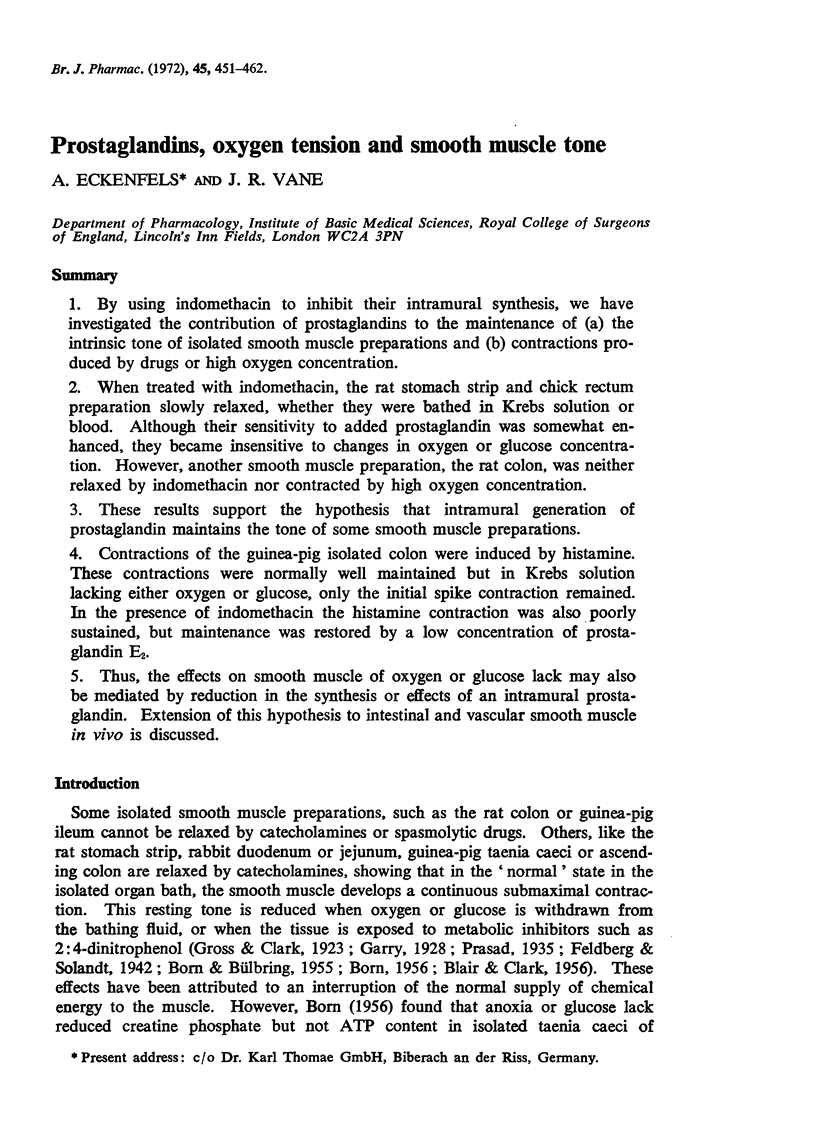
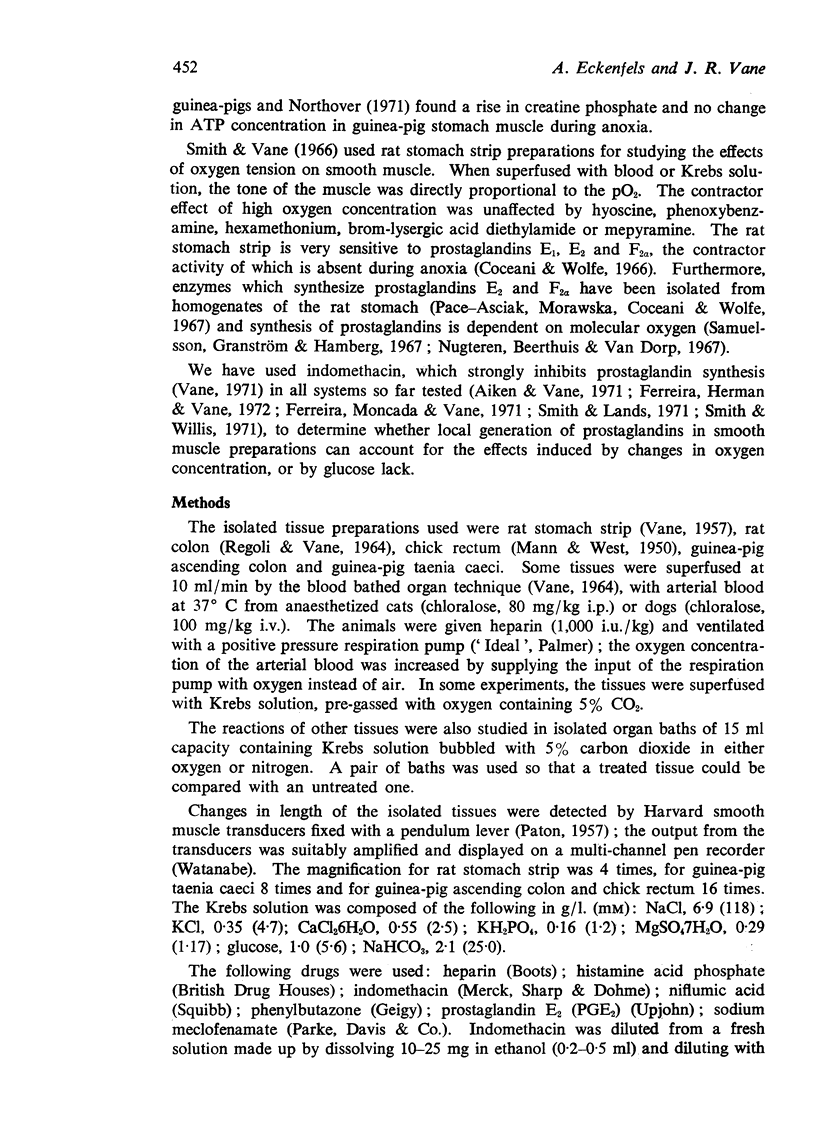
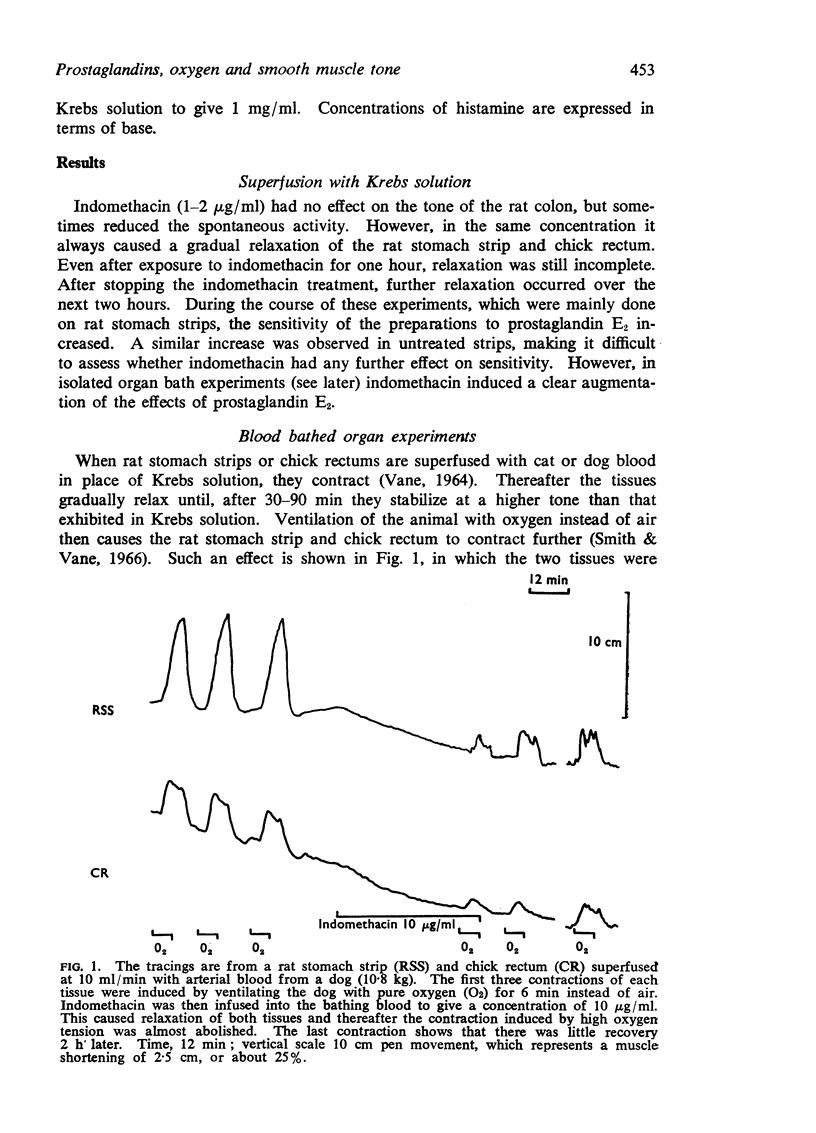

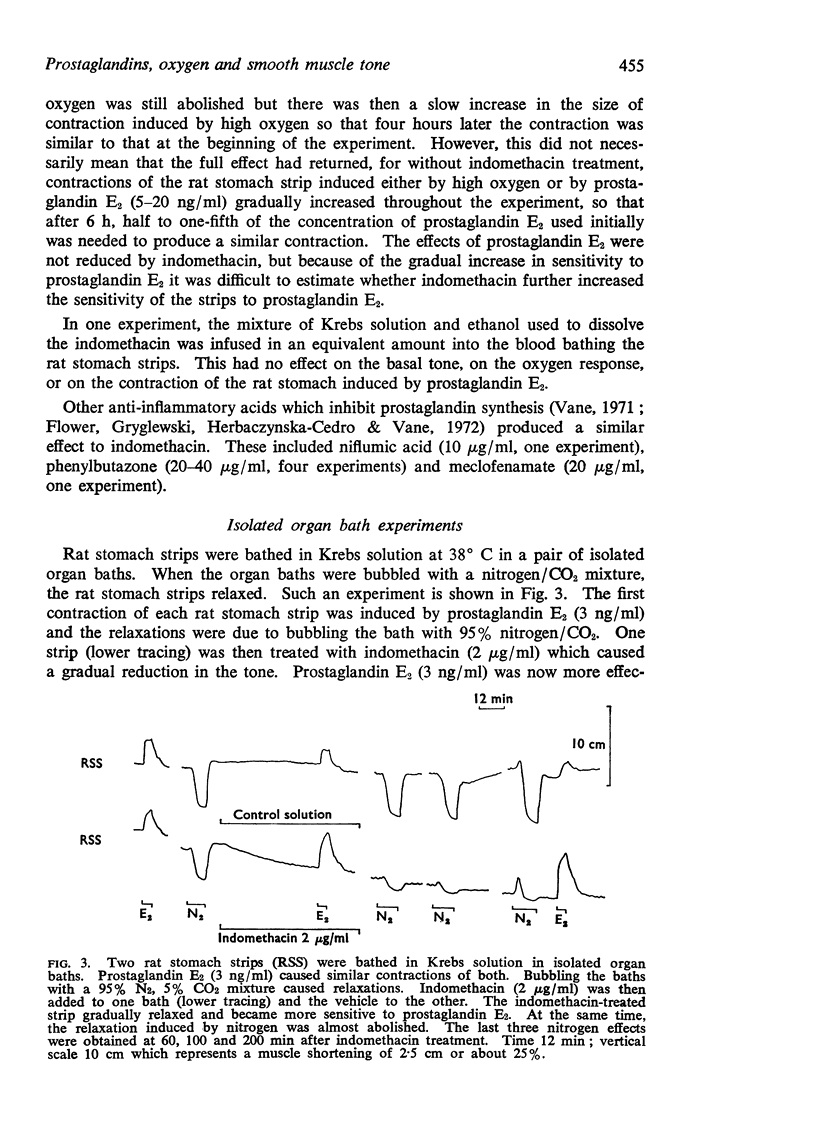

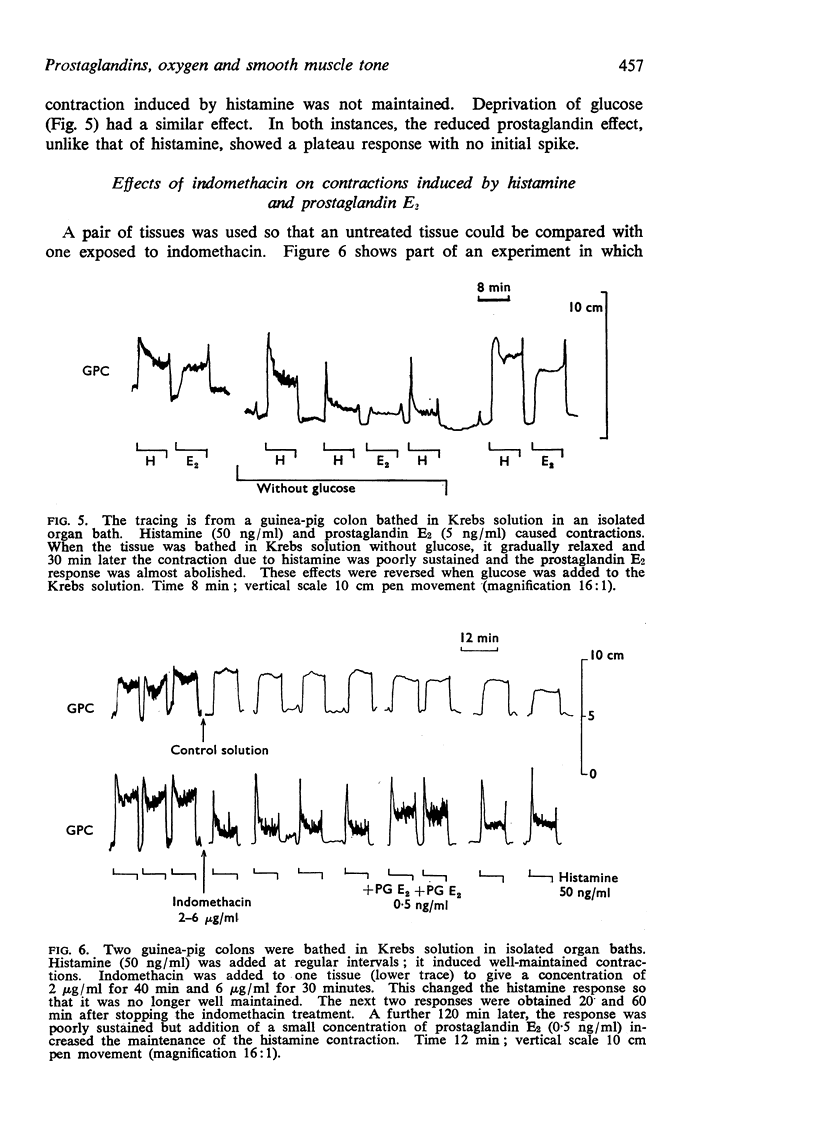
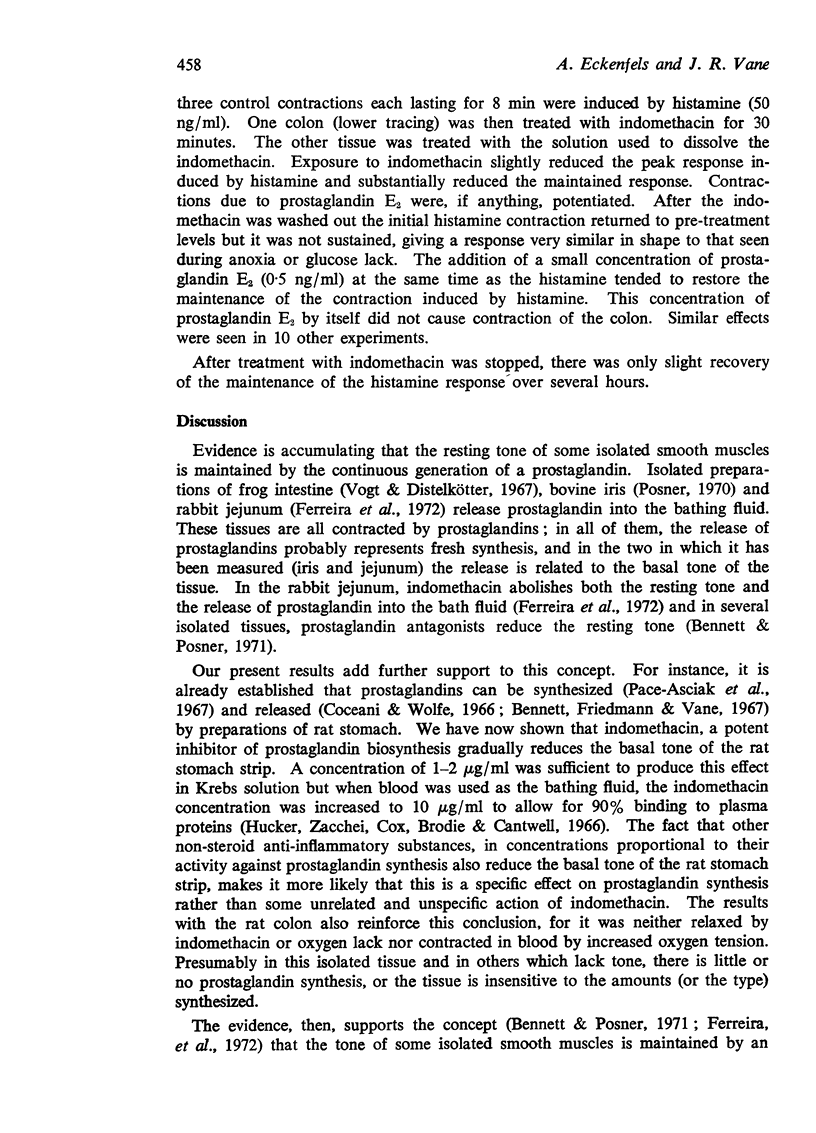

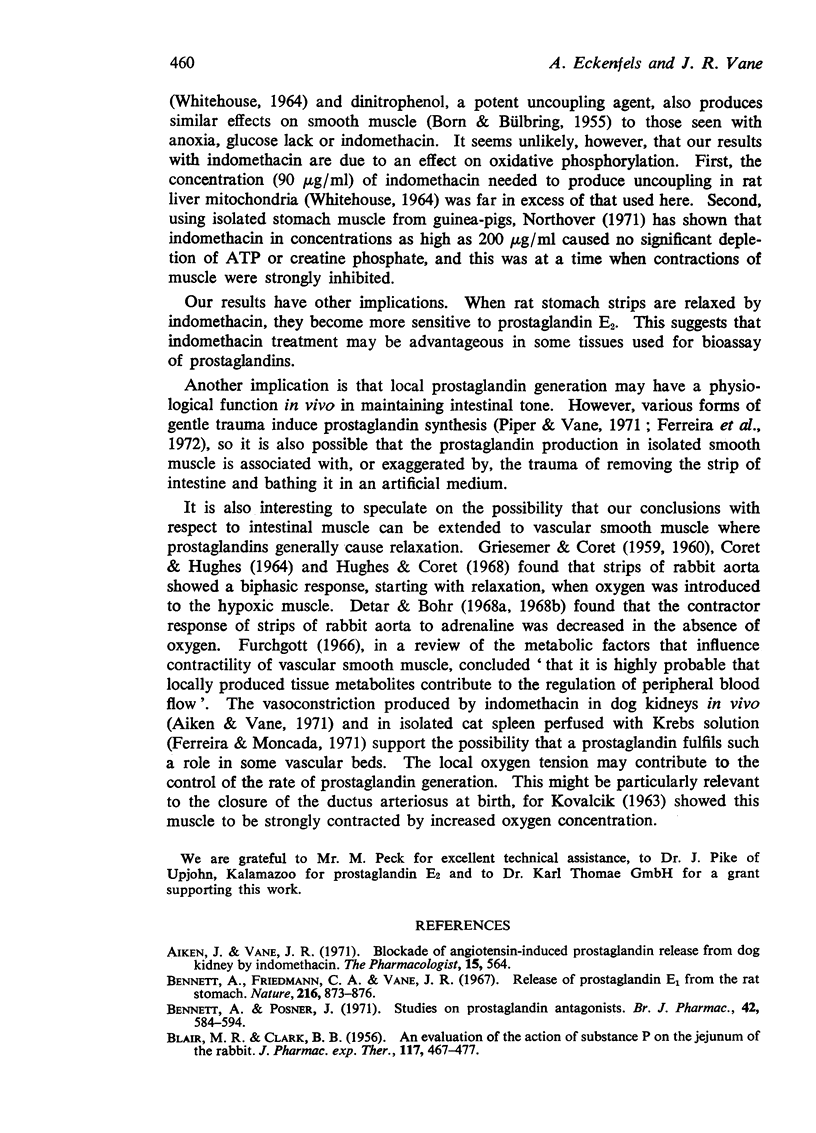
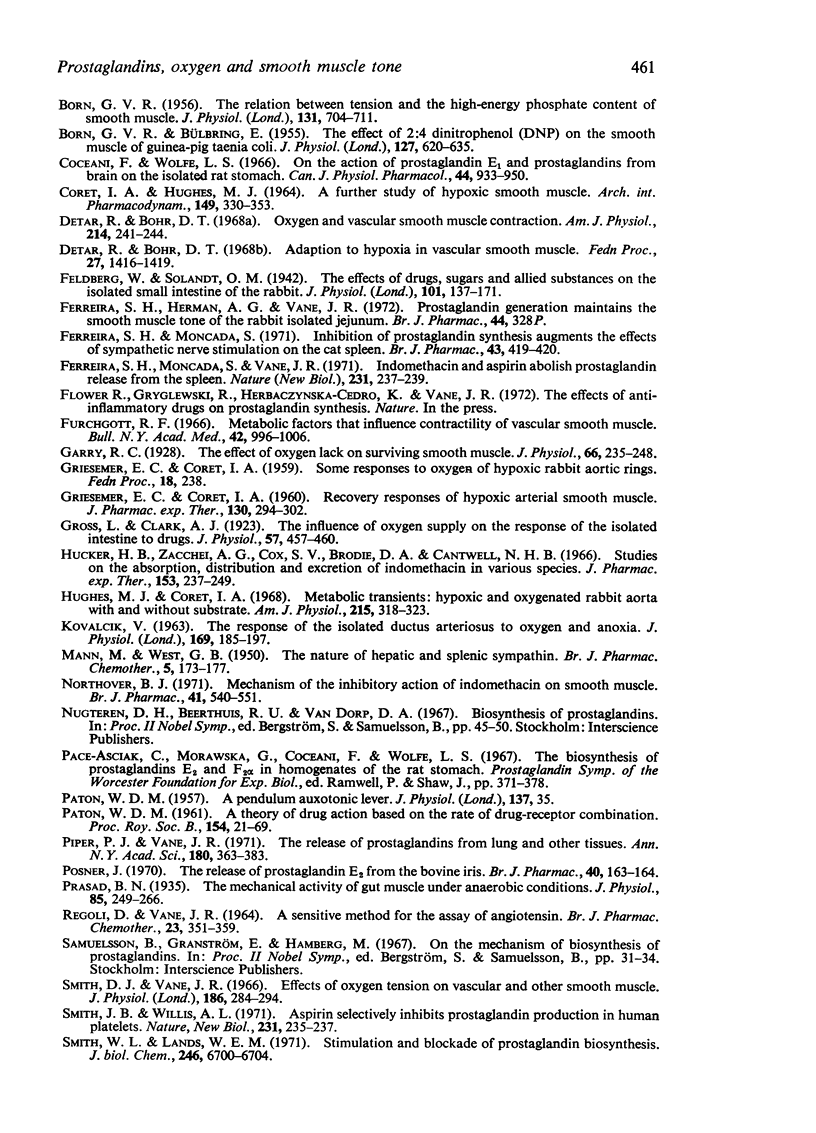

Selected References
These references are in PubMed. This may not be the complete list of references from this article.
- BLAIR M. R., CLARK B. B. An evaluation of the action of substance P on the jejunum of the rabbit. J Pharmacol Exp Ther. 1956 Aug;117(4):467–477. [PubMed] [Google Scholar]
- BORN G. V., BULBRING E. The effect of 2:4-dinitrophenol (DNP) on the smooth muscle of the guinea-pig's taenia coli. J Physiol. 1955 Mar 28;127(3):626–635. doi: 10.1113/jphysiol.1955.sp005283. [DOI] [PMC free article] [PubMed] [Google Scholar]
- BORN G. V. The relation between the tension and the high-energy phosphate content of smooth muscle. J Physiol. 1956 Mar 28;131(3):704–711. doi: 10.1113/jphysiol.1956.sp005495. [DOI] [PMC free article] [PubMed] [Google Scholar]
- Bennett A., Friedmann C. A., Vane J. R. Release of prostaglandin E-1 from the rat stomach. Nature. 1967 Dec 2;216(5118):873–876. doi: 10.1038/216873a0. [DOI] [PubMed] [Google Scholar]
- Bennett A., Posner J. Studies on prostaglandin antagonists. Br J Pharmacol. 1971 Aug;42(4):584–594. doi: 10.1111/j.1476-5381.1971.tb07142.x. [DOI] [PMC free article] [PubMed] [Google Scholar]
- CORET I. A., HUGHES M. J. A FURTHER STUDY OF HYPOXIC SMOOTH MUSCLE. Arch Int Pharmacodyn Ther. 1964 Jun 1;149:330–353. [PubMed] [Google Scholar]
- Coceani F., Wolfe L. S. On the action of prostaglandin E1 and prostaglandins from brain on the isolated rat stomach. Can J Physiol Pharmacol. 1966 Nov;44(6):933–950. doi: 10.1139/y66-116. [DOI] [PubMed] [Google Scholar]
- Detar R., Bohr D. F. Adaptation to hypoxia in vascular smooth muscle. Fed Proc. 1968 Nov-Dec;27(6):1416–1419. [PubMed] [Google Scholar]
- Detar R., Bohr D. F. Oxygen and vascular smooth muscle contraction. Am J Physiol. 1968 Feb;214(2):241–244. doi: 10.1152/ajplegacy.1968.214.2.241. [DOI] [PubMed] [Google Scholar]
- Feldberg W., Solandt O. M. The effects of drugs, sugar and allied substances on the isolated small intestine of the rabbit. J Physiol. 1942 Aug 18;101(2):137–171. doi: 10.1113/jphysiol.1942.sp003972. [DOI] [PMC free article] [PubMed] [Google Scholar]
- Ferreira S. H., Herman A., Vane J. R. Proceedings: Prostaglandin generation maintains the smooth muscle tone of the rabbit isolated jejunum. Br J Pharmacol. 1972 Feb;44(2):328P–329P. [PMC free article] [PubMed] [Google Scholar]
- Ferreira S. H., Moncada S., Vane J. R. Indomethacin and aspirin abolish prostaglandin release from the spleen. Nat New Biol. 1971 Jun 23;231(25):237–239. doi: 10.1038/newbio231237a0. [DOI] [PubMed] [Google Scholar]
- Furchgott R. F. Metabolic factors that influence contractility of vascular smooth muscle. Bull N Y Acad Med. 1966 Nov;42(11):996–1006. [PMC free article] [PubMed] [Google Scholar]
- GRIESEMER E. C., CORET I. A. "Recovery" responses of hypoxic arterial smooth muscle. J Pharmacol Exp Ther. 1960 Nov;130:294–302. [PubMed] [Google Scholar]
- Garry R. C. The effect of oxygen lack on surviving smooth muscle. J Physiol. 1928 Nov 9;66(3):235–248. doi: 10.1113/jphysiol.1928.sp002522. [DOI] [PMC free article] [PubMed] [Google Scholar]
- Gross L., Clark A. J. The influence of oxygen supply on the response of the isolated intestine to drugs. J Physiol. 1923 Aug 16;57(6):457–460. doi: 10.1113/jphysiol.1923.sp002084. [DOI] [PMC free article] [PubMed] [Google Scholar]
- Hughes M. J., Coret I. A. Metabolic transients: hypoxic and oxygenated rabbit aorta with and without substrate. Am J Physiol. 1968 Aug;215(2):318–323. doi: 10.1152/ajplegacy.1968.215.2.318. [DOI] [PubMed] [Google Scholar]
- KOVALCIK V. THE RESPONSE OF THE ISOLATED DUCTUS ARTERIOSUS TO OXYGEN AND ANOXIA. J Physiol. 1963 Nov;169:185–197. doi: 10.1113/jphysiol.1963.sp007249. [DOI] [PMC free article] [PubMed] [Google Scholar]
- MANN M., WEST G. B. The nature of hepatic and splenic sympathin. Br J Pharmacol Chemother. 1950 Jun;5(2):173–177. doi: 10.1111/j.1476-5381.1950.tb01004.x. [DOI] [PMC free article] [PubMed] [Google Scholar]
- Northover B. J. Mechanism of the inhibitory action of indomethacin on smooth muscle. Br J Pharmacol. 1971 Mar;41(3):540–551. doi: 10.1111/j.1476-5381.1971.tb08052.x. [DOI] [PMC free article] [PubMed] [Google Scholar]
- Piper P., Vane J. The release of prostaglandins from lung and other tissues. Ann N Y Acad Sci. 1971 Apr 30;180:363–385. doi: 10.1111/j.1749-6632.1971.tb53205.x. [DOI] [PubMed] [Google Scholar]
- Prasad B. N. The mechanical activity of gut muscle under anaerobic conditions. J Physiol. 1935 Oct 26;85(2):249–266. doi: 10.1113/jphysiol.1935.sp003316. [DOI] [PMC free article] [PubMed] [Google Scholar]
- REGOLI D., VANE J. R. A SENSITIVE METHOD FOR THE ASSAY OF ANGIOTENSIN. Br J Pharmacol Chemother. 1964 Oct;23:351–359. doi: 10.1111/j.1476-5381.1964.tb01591.x. [DOI] [PMC free article] [PubMed] [Google Scholar]
- Smith D. J., Vane J. R. Effects of oxygen tension on vascular and other smooth muscle. J Physiol. 1966 Oct;186(2):284–294. doi: 10.1113/jphysiol.1966.sp008034. [DOI] [PMC free article] [PubMed] [Google Scholar]
- Smith J. B., Willis A. L. Aspirin selectively inhibits prostaglandin production in human platelets. Nat New Biol. 1971 Jun 23;231(25):235–237. doi: 10.1038/newbio231235a0. [DOI] [PubMed] [Google Scholar]
- Smith W. L., Lands W. E. Stimulation and blockade of prostaglandin biosynthesis. J Biol Chem. 1971 Nov;246(21):6700–6702. [PubMed] [Google Scholar]
- VANE J. R. A sensitive method for the assay of 5-hydroxytryptamine. Br J Pharmacol Chemother. 1957 Sep;12(3):344–349. doi: 10.1111/j.1476-5381.1957.tb00146.x. [DOI] [PMC free article] [PubMed] [Google Scholar]
- VANE J. R. THE USE OF ISOLATED ORGANS FOR DETECTING ACTIVE SUBSTANCES IN THE CIRCULATING BLOOD. Br J Pharmacol Chemother. 1964 Oct;23:360–373. doi: 10.1111/j.1476-5381.1964.tb01592.x. [DOI] [PMC free article] [PubMed] [Google Scholar]
- Vane J. R. Inhibition of prostaglandin synthesis as a mechanism of action for aspirin-like drugs. Nat New Biol. 1971 Jun 23;231(25):232–235. doi: 10.1038/newbio231232a0. [DOI] [PubMed] [Google Scholar]
- WEST T. C., HADDEN G., FARAH A. Effect of anoxia on response of the isolated intestine to various drugs and enzyme inhibitors. Am J Physiol. 1951 Feb;164(2):565–572. doi: 10.1152/ajplegacy.1951.164.2.565. [DOI] [PubMed] [Google Scholar]
- WHITEHOUSE M. W. UNCOUPLING OF OXIDATIVE PHOSPHORYLATION BY SOME ARYLACETIC ACIDS (ANTI-INFLAMMATORY OR HYPERCHOLESTEROLEMIC DRUGS). Nature. 1964 Feb 8;201:629–630. doi: 10.1038/201629a0. [DOI] [PubMed] [Google Scholar]


